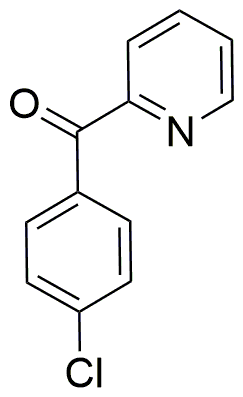2-(4-Chlorobenzoyl)pyridine is widely utilized in research focused on:
- Pharmaceutical Development: This compound serves as a key intermediate in the synthesis of various pharmaceuticals, particularly in the development of anti-inflammatory and analgesic drugs.
- Agricultural Chemicals: It is used in formulating agrochemicals, including herbicides and fungicides, enhancing crop protection and yield.
- Material Science: The compound is incorporated into polymer formulations, improving thermal stability and mechanical properties, which is beneficial in creating durable materials.
- Analytical Chemistry: It acts as a reagent in analytical methods, aiding in the detection and quantification of other compounds in complex mixtures.
- Biochemical Research: Researchers utilize it in studies related to enzyme inhibition and receptor binding, providing insights into biological processes and potential therapeutic targets.
Informations générales
Propriétés
Sécurité et réglementation
Applications
2-(4-Chlorobenzoyl)pyridine is widely utilized in research focused on:
- Pharmaceutical Development: This compound serves as a key intermediate in the synthesis of various pharmaceuticals, particularly in the development of anti-inflammatory and analgesic drugs.
- Agricultural Chemicals: It is used in formulating agrochemicals, including herbicides and fungicides, enhancing crop protection and yield.
- Material Science: The compound is incorporated into polymer formulations, improving thermal stability and mechanical properties, which is beneficial in creating durable materials.
- Analytical Chemistry: It acts as a reagent in analytical methods, aiding in the detection and quantification of other compounds in complex mixtures.
- Biochemical Research: Researchers utilize it in studies related to enzyme inhibition and receptor binding, providing insights into biological processes and potential therapeutic targets.
Documents
Fiches de données de sécurité (FDS)
La FDS fournit des informations de sécurité complètes sur la manipulation, le stockage et l’élimination du produit.
Spécifications du produit (PS)
Le PS fournit une description complète des propriétés du produit, notamment sa composition chimique, son état physique, sa pureté et les exigences de stockage. Il détaille également les plages de qualité acceptables et les applications prévues du produit.
Certificats d'analyse (COA)
Recherchez des certificats d'analyse (COA) en saisissant le numéro de lot du produit. Les numéros de lot et de lot se trouvent sur l'étiquette d'un produit, après les mots « Lot » ou « Lot de fabrication ».
Numéro de catalogue
Numéro de lot/série
Certificats d'origine (COO)
Ce certificat d'exploitation confirme le pays dans lequel le produit a été fabriqué, et détaille également les matériaux et composants utilisés et s'il est issu de sources naturelles, synthétiques ou autres sources spécifiques. Ce certificat peut être requis pour les douanes, le commerce et la conformité réglementaire.
Numéro de catalogue
Numéro de lot/série
Fiches de données de sécurité (FDS)
La FDS fournit des informations de sécurité complètes sur la manipulation, le stockage et l’élimination du produit.
DownloadSpécifications du produit (PS)
Le PS fournit une description complète des propriétés du produit, notamment sa composition chimique, son état physique, sa pureté et les exigences de stockage. Il détaille également les plages de qualité acceptables et les applications prévues du produit.
DownloadCertificats d'analyse (COA)
Recherchez des certificats d'analyse (COA) en saisissant le numéro de lot du produit. Les numéros de lot et de lot se trouvent sur l'étiquette d'un produit, après les mots « Lot » ou « Lot de fabrication ».
Numéro de catalogue
Numéro de lot/série
Certificats d'origine (COO)
Ce certificat d'exploitation confirme le pays dans lequel le produit a été fabriqué, et détaille également les matériaux et composants utilisés et s'il est issu de sources naturelles, synthétiques ou autres sources spécifiques. Ce certificat peut être requis pour les douanes, le commerce et la conformité réglementaire.


